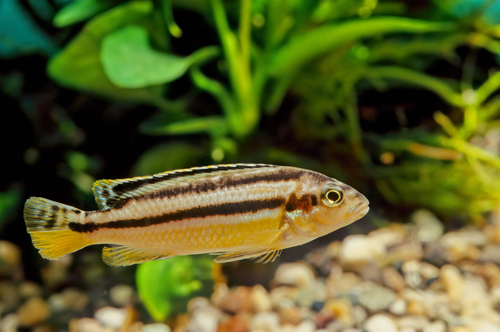The Auratus cichlid can become a wonderful addition to your aquarium as long as you understand how to take proper care of this rather aggressive species. You would have to know the ideal Auratus cichlid tank mates before introducing any newbies to the tank.
If you don’t like the idea of having a single-species aquarium, then you might want to opt for other African cichlids because they have similar temperament and thrive in similar water conditions.
If you’re looking for a few other not-so-obvious tank mate choices, then keep on reading.
Contents
Auratus Cichlid Tank Mates – What You Need to Know
Here are the main things that you would have to consider before getting a new tank mate for your beautiful Auratus cichlid.
Temperament
Auratus cichlids are a very aggressive species. This is true for both females and males.
That’s why it’s not recommended to house the bully with peaceful cichlids or with fish that are shy or prone to stress. Other non-aggressive fish might end up feeling okay in a tank that is inhabited by Auratus cichlids if they are a lot bigger in size.
Size
The average size of this cichlid is around 4.5 inches. However, with proper care, the fish can get bigger. The males are slightly bigger than the females.
Typically, the size of the tank mates that you’re planning on introducing to your Auratus cichlid does not really matter. These bullies can attack even the species that are twice as big if the newbie looks like an Auratus and/or is a male.
Competition
There will be plenty of aggression and competition in the tank if you choose to get a few males. Also, do bear in mind that female Auratus cichlids can become aggressive as well. In fact, they may end up killing subordinate males.
As a rule of thumb, do not keep this fish in a small tank with similar-looking males of other species. Ideally, you would want to have one male Auratus cichlid to reduce the chances of a disaster happening.
Parameters and Tank Setup
A single Auratus cichlid should have a tank that is at least 50 gallons big. If you want to raise more fish, opt for a tank that is at least 120 gallons with plenty of rocks and hiding space to reduce the chances of conflict.
The bigger the tank, the fewer fights for territory the fish will have. If your aquarium is very large, you might even end up successfully raising two males.
The Auratus cichlid can thrive in any water (freshwater or brackish), you would just have to ensure that there is proper water movement in the tank and efficient filtration. The temperature should be kept between 73 and 82 degrees and the pH level – between 7.7 and 8.6.
Before choosing a tank mate, make sure that the newbie would be able to thrive in such water conditions.
12 Best Auratus Cichlid Tank Mates
Even though the Auratus cichlid is quite an aggressive little guy, these 12 species of fish might make great tank mates for the bully.
- Auratus Cichlid
- Yellow Lab
- Snow White Cichlid
- Kenyi Cichlid
- Zebra Obliquidens
- Demasoni Cichlid
- Red Zebra
- Cobalt Blue
- Synodontis Catfish
- Giant Danio
- Leopard Bush Fish
- Suckermouth Catfish
Check out these other related posts:
- Green Spotted Puffer Tank Mates
- Chili Rasbora Tank Mates
- Kribensis Cichlid Tank Mates
- Golden Severum Tank Mates
1. Auratus Cichlid
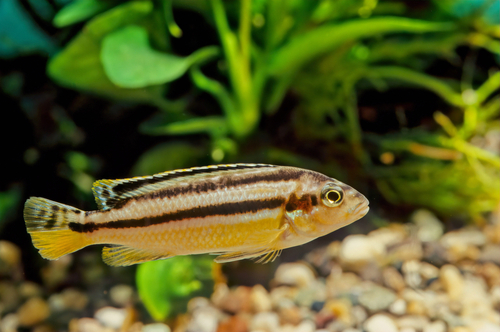
- Scientific Name: Melanochromis auratus
- Adult Size: around 4.5 inches
- Compatible with: Auratus cichlid and other Malawi cichlids
- Care Level: moderate
- Origin: Lake Malawi in East Africa
An aquarium full of Auratus cichlids can be anything but boring. These aggressive fish do quite well in a single species tank as long as you were able to get one male and a few females.
The word “auratus” is Latin for gold which is how these fish got their name, but at maturity, males will color morph from golden to dark blue. This is usually the point where you will start to see more aggression.
Pros of keeping with Auratus Cichlid:
- The beautiful fish are less likely to bully each other if they are of the same species.
Cons of keeping with Auratus Cichlid:
- These cichlids can become aggressive even if there is only one male. Especially if the tank is too small for them.
2. Yellow Lab
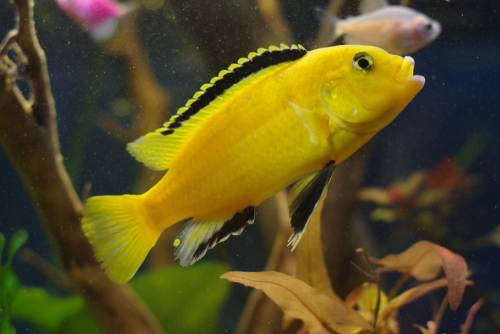
- Scientific Name: Labidochromis caeruleus
- Adult Size: 4 inches
- Compatible with: Convict Cichlid, Peacock Cichlid, Auratus Cichlid
- Care Level: moderate
- Origin: Lake Malawi
The Electric Yellow Cichlid is docile and peaceful. However, it can be aggressive towards fish with similar colors and shapes, so don’t let the little guy look at itself in the mirror. It can definitely hold its own in a tank with Auratus Cichlids.
Pros of keeping with Auratus Cichlid:
- As both species come from Lake Malawi, they would be happy with the same water parameters.
Cons of keeping with Auratus Cichlid:
- Despite the name, the Yellow Lab can come in a wide range of different colors. If you choose a male that looks similar to the Auratus cichlid, both fishes might initiate a fight.
3. Snow White Cichlid
- Scientific Name: Pseudotropheus socolofi Albino
- Adult Size: 6 inches
- Compatible with: Auratus, Yellow Lab, Red Zebra
- Care Level: moderate
- Origin: Lake Malawi
These peaceful cichlids are socially active and can get along with non-aggressive fish quite well. The species is quite uncommon and has an entirely white body and striking red eyes.
Pros of keeping with Auratus Cichlid:
- Both species are from Lake Malawi, so they’ll enjoy the same food and water parameters.
Cons of keeping with Auratus Cichlid:
- If you don’t have a big tank, the Snow White cichlid can get territorial, just like the Auratus.
4. Kenyi Cichlid
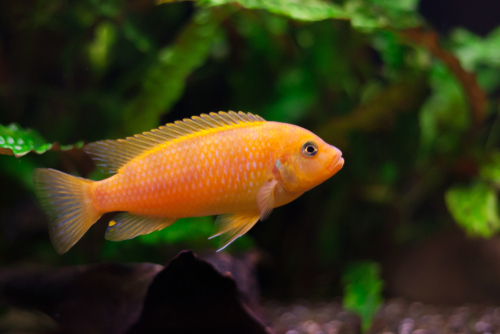
- Scientific Name: Maylandia lombardoi
- Adult Size: 5.1 inches
- Compatible with: other Mbunas of similar size but different colors
- Care Level: moderate
- Origin: Lake Malawi
The Kenyi cichlid is one of the most aggressive species available on the market. The gorgeous fish can add vibrant colors to the aquarium and, if taken care of properly, live up to 15 years!
Pros of keeping with Auratus Cichlid:
- Both of these species have similar temperaments and the same water parameters.
Cons of keeping with Auratus Cichlid:
- The creatures might kill each other if you decide to introduce another male.
5. Zebra Obliquidens
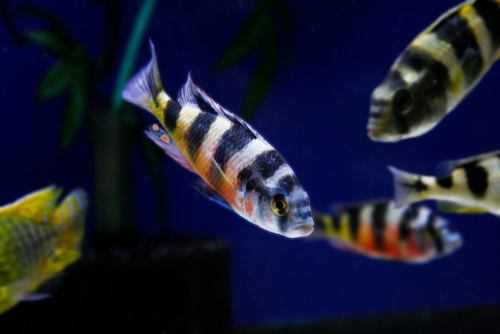
- Scientific Name: Astatotilapia latifasciata
- Adult Size: up to 5 inches
- Compatible with: other African cichlids
- Care Level: moderate
- Origin: Uganda
The Zebra Obliquidens is becoming heavily bred in the industry as it may be nearing extinction in the wild. These cuties get along with other fish quite well as long as they have enough hiding places to provide them with a sense of security.
Pros of keeping with Auratus Cichlid:
- Both have the same water parameters.
Cons of keeping with Auratus Cichlid:
- In some cases, the Zebra Obliquidens might feel threatened by the Auratus.
6. Demasoni Cichlid

- Scientific Name: Pseudotropheus demasoni
- Adult Size: 3 inches
- Compatible with: other aggressive Mbuna
- Care Level: moderate to hard
- Origin: Lake Malawi
These cichlids have to be kept in groups as this would help them dissipate their aggression levels (a group of 12 would be perfect). The female-to-male ratio should be kept at around 5:1 so that the males do not exhaust the ladies by chasing them.
Pros of keeping with Auratus Cichlid:
- They both eat the same food and thrive in the same type of water.
Cons of keeping with Auratus Cichlid:
- If your Demasoni and Auratus have similar colors, they might attack each other.
7. Red Zebra
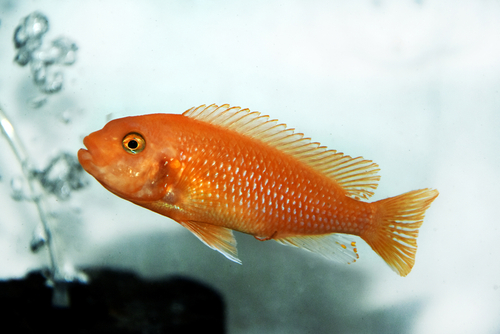
- Scientific Name: Maylandia estherae
- Adult Size: up to 5 inches
- Compatible with: Bumblebee Cichlids, Cuckoo Catfish, Aurora Cichlids, Hongi Cichlids
- Care Level: moderate
- Origin: Lake Malawi
Despite the name, this pretty fish is not always red and does not always have stripes. The most notable feature of a Red Zebra are egg-shaped spots (usually, of a contrasting color) that you’ll find next to the anal fin.
Pros of keeping with Auratus Cichlid:
- They have the same water requirements.
Cons of keeping with Auratus Cichlid:
- If the tank is not big enough, the two species can become violent toward each other.
8. Cobalt Blue
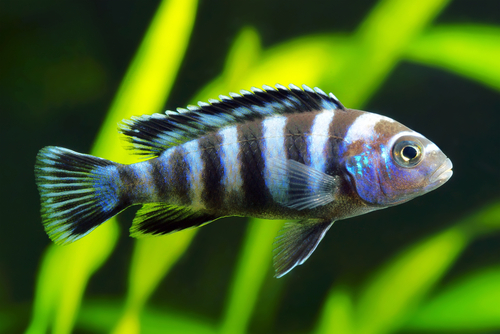
- Scientific Name: Maylandia callainos
- Adult Size: 3-5 inches
- Compatible with: Mbunas
- Care Level: moderate
- Origin: Lake Malawi
Cobalt Blue cichlids are territorial and aggressive and like to claim territory in the vicinity of caves and crevices. During the spawning season, they can become even more aggressive.
Pros of keeping with Auratus Cichlid:
- Both of these species have similar temperaments and are able to defend themselves. As long as you have one male per group and a large tank, everything should be okay.
Cons of keeping with Auratus Cichlid:
- There will most likely be occasional fights.
9. Synodontis Catfish
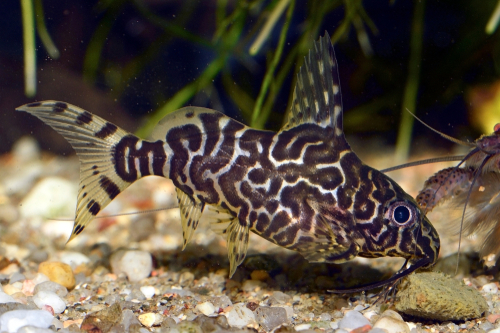
- Scientific Name: Synodontis
- Adult Size: about 8 inches
- Compatible with: African cichlids, large barbs, rainbowfish
- Care Level: moderate
- Origin: Africa
Though there are over 120 different species of Synodontis catfish, the majority of them make great tank mates for cichlids. These bottom-dwellers are easy-going but have the means to protect themselves.
Pros of keeping with Auratus Cichlid:
- Both species have practically the same water requirements.
Cons of keeping with Auratus Cichlid:
- Ideally, you would want to keep the catfish in a group of 4-5 fish which your Auratus might not like. Especially if your tank is not big enough.
10. Giant Danio
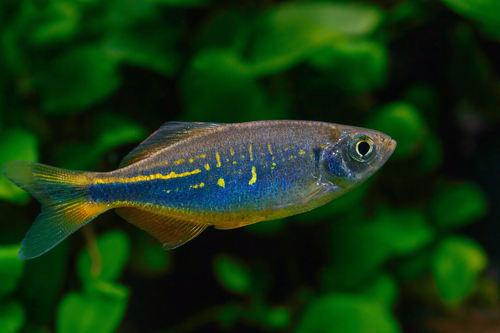
- Scientific Name: Devario aequipinnatus
- Adult Size: 4-6 inches
- Compatible with: similar-sized, robust fish
- Care Level: easy
- Origin: India, Nepal, Sri Lanka
These little guys are highly adaptable and active, but they need to be kept in groups of at least 6-8. As the species is incredibly resilient, it can easily thrive in different parameters.
Pros of keeping with Auratus Cichlid:
- If you adopt at least 6 of the danios, the energetic fish will live in peace with the Auratus.
Cons of keeping with Auratus Cichlid:
- If juvenile giant danios get introduced to the tank, they might get eaten.
11. Leopard Bush Fish
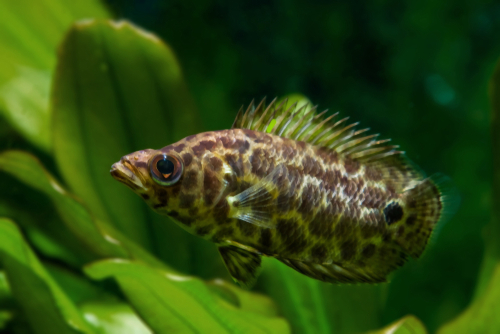
- Scientific Name: Ctenopoma acutirostre
- Adult Size: 6 inches
- Compatible with: cichlids, swordtails, and other fish similar in size
- Care Level: moderate
- Origin: Africa
The predator will trick smaller fish into thinking that it’s just a piece of leaf, and then attack the tiny guys. Thankfully, this will not be the case with your Auratus cichlids, as long as they are already fully grown.
Pros of keeping with Auratus Cichlid:
- Both species are pretty much of the same size and have the same water requirements which makes them a good match.
Cons of keeping with Auratus Cichlid:
- If the Auratus cichlids are overly aggressive, the leopard bush fish might get scared and stressed out.
12. Suckermouth Catfish
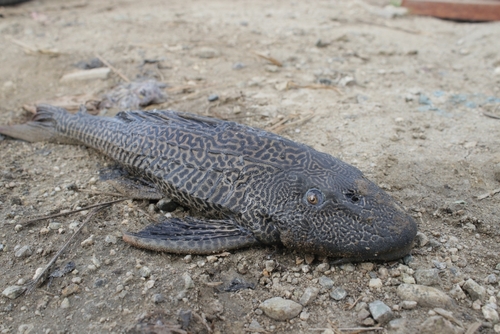
- Scientific Name: Hypostomus plecostomus
- Adult Size: about 24 inches
- Compatible with: angelfish, neon tetra, some cichlids
- Care Level: easy
- Origin: South America
Also known as Pleco, this bottom-dweller is very peaceful. Though it can become a bit more aggressive as it gets bigger and older, you shouldn’t experience any issues, as long as the tank is big enough.
Pros of keeping with Auratus Cichlid:
- The suckermouth catfish can easily defend itself even when dealing with the aggressive Auratus cichlids.
Cons of keeping with Auratus Cichlid:
- You are going to need a very large tank.
In Conclusion
In general, the best Auratus cichlid tank mates also have their origins in Africa and belong to the same family.
Although it might feel like you can’t go wrong with such a choice, you should always keep an eye on your fish, and place them in different tanks if the Auratus ever becomes way too aggressive.

Ian Sterling, founder of Fishlab.com, began his aquarium journey over 30 years ago, driven by a deep fascination for fish and their diverse personalities. His website, Fishlab.com, is dedicated to making fishkeeping accessible and enjoyable, offering beginner-friendly guidance, expert insights, and a community for aquarists to connect and share experiences.


